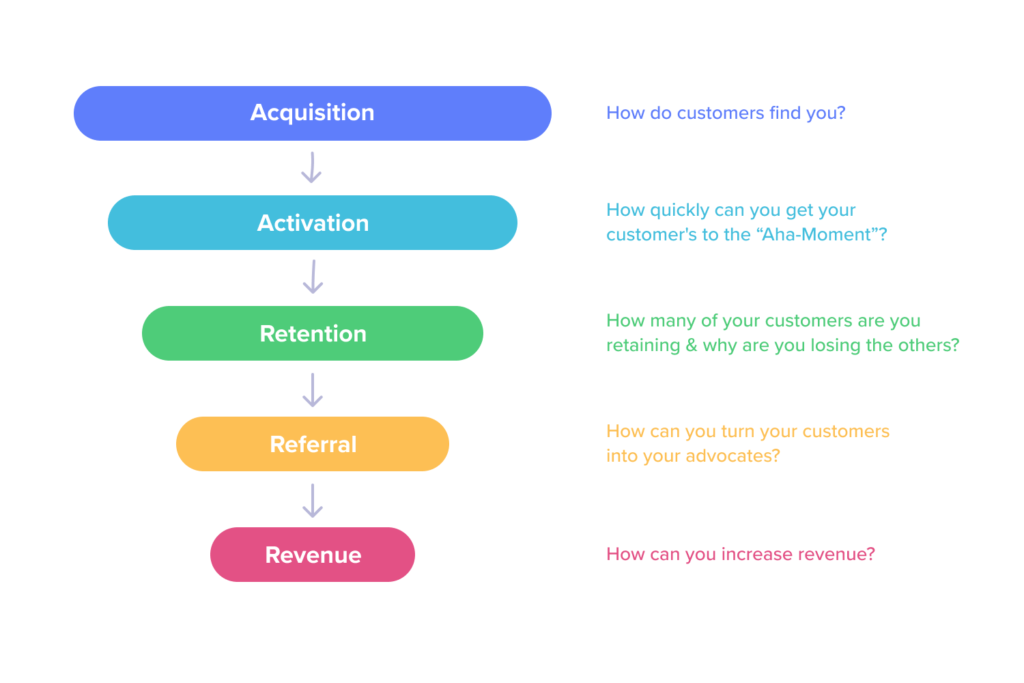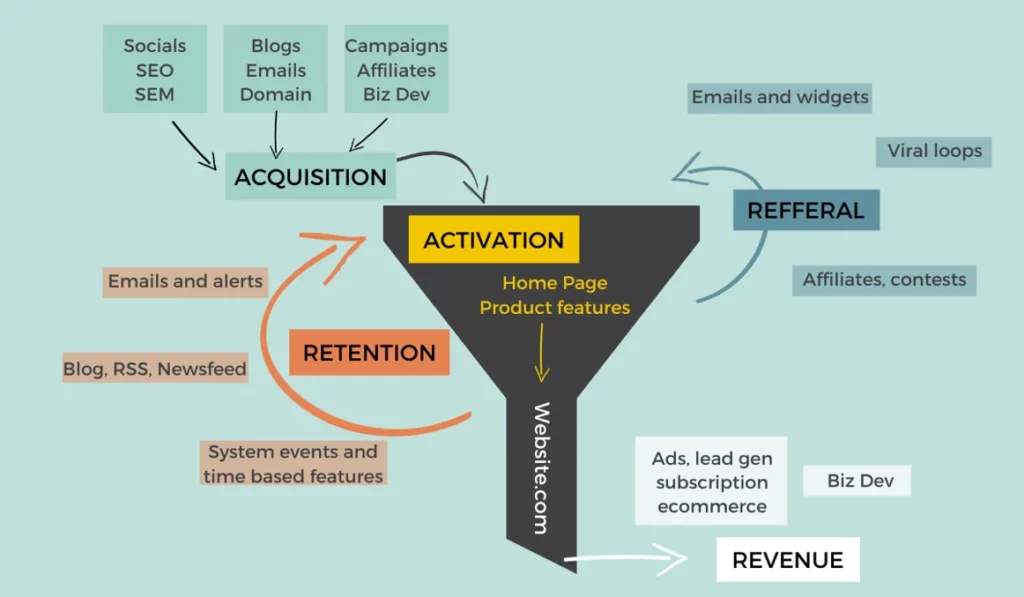This article is part of our series on subscription strategies, whether you’re looking to launch your subscription offer or optimize an existing one. 😃
This series covers all aspects of the topic: acquisition, conversion, customer retention, and KPIs.
The AARRR framework—often referred to as the “Pirate Metrics Framework“—is a crucial tool for companies looking to optimize their growth strategy.
The model, theorized by Dave McClure, a Silicon Valley pioneer, former CMO of PayPal, and founder of 500 Startups, breaks down a typical customer’s life cycle into clear, measurable stages, represented as a funnel.
These stages are essential for effectively modeling and managing the growth drivers of any business.
In this article, you’ll discover the benefits of the AARRR framework and our advice on integrating it into your processes.
What exactly is AARRR?
The AARRR framework divides the customer journey into five key stages:
- Acquisition,
- Activation,
- Retention,
- Revenue,
- Referral.
Now that you have the acronym, let’s see how each of these stages fits into your customer journey, from the first contact to customer retention and self-promotion.
By segmenting the customer journey, this model allows companies to precisely target each phase, identifying strengths and areas for performance improvement.
Integrated into the growth hacking context, this model offers a methodical and bold approach to stimulating your company’s growth.

Framework stages: Acquisition, Activation, Retention, Revenue, Referral
1. Customer acquisition
Acquisition is the first step of the AARRR framework. It involves attracting users to your site through various channels such as SEO, content marketing, paid advertising, and partnerships.
An effective acquisition strategy must be well-targeted to reach the desired audience.
To achieve this, it’s important to rely on audience data from each channel to optimize campaigns, reduce costs, and maximize the volume of qualified traffic.
→ Examples of acquisition channels:
- SEO: Optimizing the site to improve organic visibility on search engines.
- Paid Advertising: Using platforms like Google Ads or Facebook Ads to display ads to a specific audience.
- Partnerships: Collaborating with other companies to share audiences.
2. User activation
After acquisition, the activation stage aims to turn your website’s audience into active and engaged users.
Here, you should optimize the onboarding process to increase the website’s conversion rate.
You can also implement specific calls to action, such as content downloads or free trials, to encourage users to take action.
→ Strategies for Effective Activation:
- Simplified Onboarding: Reduce all friction during the first interactions (e.g., not requiring a credit card at registration).
- Freemium or Free Trial Offers: Allow users to test the product without financial commitment.
- Educational Content: Create high-value content that attracts and retains prospects’ attention.
3. Customer retention
Retention refers to a company’s ability to keep its customers active and engaged after their first use of the product.
The priority here is to offer a product or service that closely meets customer needs.
This requires a deep understanding of their motivation and continuous adjustment of offers to ensure they meet needs over time.
Tactics like regular emails, notifications, or loyalty programs are essential to maintaining customer interest.
→ Methods to improve retention:
- Loyalty Programs: Reward customers for their continued engagement.
- Personalized Emails: Send targeted communications based on user behavior.
- Regular Product Updates: Continuously innovate and improve the product to meet customer expectations.
4. Revenue
This stage focuses on monetizing the user base. Revenue models may vary: subscriptions, freemium offers, and usage-based billing are some options.
The key is to find a balance between the value offered and the revenue generated. It’s also important to ensure that prices and offers are suited to different customer segments.
→ Monetization Options:
- Subscriptions: Recurring payment model for continuous access to the product.
- Freemium: Offer a basic product for free with paid options for advanced features.
- Cross-sell and Upsell: Offer existing customers complementary products or services.

5. Referral
Encouraging users to recommend your product to other potential customers is the final step of the AARRR framework.
Referral programs or incentives to post reviews can facilitate this process.
Referral programs can boost customer acquisition at a lower cost.
According to a study conducted by Wharton Business School, the customer acquisition cost (CAC) for referred customers is $23.12 lower than that of non-referred customers.
User recommendations—often perceived as more authentic—also enable faster growth.
For example, Dropbox experienced astronomical growth, gaining 4 million users in just 15 months, with 35% of all sign-ups coming from the referral program.
→ Strategies to Encourage Referrals:
- Referral Programs: Offer incentives (gifts, discounts) for each new customer referred.
- Review Collection: Encourage users to share their positive experiences on public platforms.
Bonus: Awareness
Some companies add “Awareness” at the beginning of the framework, creating an AAARRR model to distinguish brand visibility from acquisition. The customer journey begins even before interaction with the site through content distributed on external channels like social media or partner sites.
→ Difference Between Awareness and Acquisition:
Source : propello
- Awareness: Focus on brand visibility.
- Acquisition: Convert this visibility into website traffic.
Why structure around AARRR?
Adopting the AARRR framework offers significant advantages for strategic customer journey management:
Comprehensive view of the customer journey
The AARRR framework simplifies visualizing the customer journey, from the first interaction to referral.
It allows companies to quickly spot optimization opportunities.
Effective prioritization
The framework also helps prioritize actions based on their potential impact on the customer journey.
For example, improving activation is often more effective than focusing solely on traffic acquisition: this step requires less effort and yields faster results.
Maximizing customer value
By targeting and optimizing specific stages like activation and retention, companies can significantly increase their conversion rates and thus the number of active customers.
By improving the customer experience, they increase loyalty, reducing acquisition costs while boosting long-term revenue.
Because a satisfied customer is naturally more inclined to recommend products or services, their support increases organic reach and reduces advertising costs.
In summary, the AARRR framework offers a structure that allows you to dissect and improve every stage of the customer journey.
It provides a clear method for aligning marketing and sales efforts with real customer needs, optimizing resources to achieve maximum ROI.
How to define your framework?
To set up an effective AARRR framework, it’s essential to accurately model the user journey, from the initial awareness to customer retention or departure.
Here’s how to structure this process step by step:
1. Modeling the user journey
- Initial Stage: Start by identifying how users discover your brand. This includes advertising, partnerships, SEO, or social media.
- Engagement: Observe how users interact with your service or product for the first time, whether through a website visit or a meeting with a salesperson.
- Conversion: Map out the path leading to a service sign-up.
- Revenue: Document the various offers your customers choose, as well as the distribution of your Revenue or MRR (Monthly Recurring Revenue).
- Retention and Churn: Formalize the actions related to customer engagement and identify the moments and reasons why they stop using your service or product.
2. Integrating the AARRR framework
- Associate each identified stage with a phase of the AARRR framework. For example, discovery can be linked to Acquisition and the first purchase to Revenue.
3. Defining key performance indicators (KPIs)
- Choosing Indicators: Each stage of the framework should be measured by KPIs. Use indicators such as the number of new visitors for Acquisition or the conversion rate for Activation.
4. Setting up data sources and creating a Dashboard
- Data Sources: Identify the tools that collect the necessary data for each KPI. These could be tools like Google Analytics for web traffic, CRM systems for sales, or feedback platforms for retention.
- Automated Dashboard: Use tools like Looker (formerly Google Data Studio), Tableau, or Microsoft Power BI to create a dashboard that centralizes all data and allows real-time tracking.
By following these steps, you can not only define an AARRR framework aligned with your business but also ensure you have the tools in place to continually measure and improve the effectiveness of your growth strategy.
How to Improve Performance with the AARRR Framework?
The AARRR framework optimizes the customer journey by identifying and improving key points.
- Calculate your initial performance: Identify baseline values at each stage to understand your current performance.
- Identify weaknesses: Determine the stages where users lose interest or fail to convert. Pinpoint the moments that require improvement.
- Plan and prioritize: Define specific actions for each identified weakness. For example, improve the user interface or simplify the purchase process.
- Test and adjust: Implement these changes and use A/B testing to evaluate their effectiveness. Adjust strategies based on the results.
- Monitor performance: Create an AARRR dashboard to track improvements and respond quickly to new data.
By following these steps, you can not only identify weak areas—where users drop off—but also take targeted actions to improve conversion rates and overall satisfaction.
Example of Applying the AARRR Framework:
Each company adapts the AARRR framework to its situation. It depends on the product, internal processes, sales funnel, and business model.
To illustrate this, let’s take the example of Uber, which applied the AARRR framework in a concrete and effective way:
- Acquisition: Uber attracts new users through targeted advertising campaigns and discounts for first rides. They also use strategic partnerships and social media promotions to increase app downloads.
- Activation: To ensure new users take their first ride, Uber often offers free or heavily discounted rides after registration. This encourages users to try the service soon after downloading the app.
- Retention: Uber uses push notifications and personalized emails to remind users to use the service. They also offer regular promotions and a loyalty program to encourage continuous use.
- Revenue: In addition to standard rides, Uber offers complementary services like Uber Black and Uber Eats, thereby diversifying revenue streams. Their dynamic pricing strategy increases the average order value during periods of high demand.
- Referral: Uber has implemented a referral program. Existing users can invite friends and receive free ride credits in return. This method boosts new user acquisition while rewarding loyal customers.
Some Best Practices
To get the most out of the AARRR framework, here are some key practices to adopt:
1. KPI Alignment
Ensure that your KPIs are aligned with your company’s strategic objectives. This guarantees that all actions support your macro goals.
2. Concrete actions
Associate each step of the AARRR framework with specific actions; this makes it easier to identify areas for optimization.
3. Use of tracking tools
Use analytical tools like Google Analytics, Tableau, and others to monitor performance at each stage. Adjust strategies accordingly.
4. Culture of iteration
Encourage continuous testing and the adaptation of strategies based on collected data. This helps to constantly improve the effectiveness of your actions.
5. Personalization of experiences
Use data to personalize user interactions. This enhances their engagement and satisfaction.
Read also :
→ Usage Economy: Definition and perspective on sustainable consumption
→ Everything you need to know about the Freemium Model
→ All the benefits of the Subscription Business Model
→ Master OKRs: The key to achieving your strategic goals
→ How to improve your operations management with dashboards




